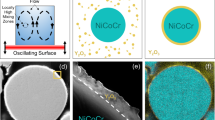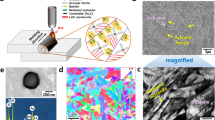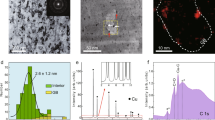Abstract
Creep is a time-dependent mechanism of plastic deformation, which takes place in a range of materials under low stress—that is, under stresses lower than the yield stress1. Metals and alloys can be designed to withstand creep at high temperatures, usually by a process called dispersion strengthening2, in which fine particles are evenly distributed throughout the matrix. For example, high-temperature creep-resistant ferritic steels achieve optimal creep strength (at 923 K) through the dispersion of yttrium oxide nanoparticles3. However, the oxide particles are introduced by complicated mechanical alloying techniques and, as a result, the production of large-scale industrial components is economically unfeasible. Here we report the production of a 9 per cent Cr martensitic steel dispersed with nanometre-scale carbonitride particles using conventional processing techniques. At 923 K, our dispersion-strengthened material exhibits a time-to-rupture that is increased by two orders of magnitude relative to the current strongest creep-resistant steels4. This improvement in creep resistance is attributed to a mechanism of boundary pinning by the thermally stable carbonitride precipitates. The material also demonstrates enough fracture toughness. Our results should lead to improved grades of creep-resistant steels and to the economical manufacture of large-scale steel components for high-temperature applications.
This is a preview of subscription content, access via your institution
Access options
Subscribe to this journal
Receive 51 print issues and online access
$199.00 per year
only $3.90 per issue
Buy this article
- Purchase on Springer Link
- Instant access to full article PDF
Prices may be subject to local taxes which are calculated during checkout




Similar content being viewed by others
References
Evans, R. W. & Wilshire, B. Creep of Metals and Alloys 1–308 (The Institute of Metals, London, 1985)
Strudel, J.-L. in Physical Metallurgy (eds Cahn, R. & Haasen, P.) Ch. 22, 1412–1486 (North-Holland, Amsterdam/Oxford/New York/Tokyo, 1983)
Ukai, S., Nishida, T., Okuda, T. & Yoshitake, T. R&D of oxide dispersion strengthened ferritic martensitic steels for FBR. J. Nucl. Mater. 258/263, 1745–1749 (1998)
Bakker, W. T. & Nath, B. in Proc. 3rd EPRI Conference on Advances in Materials Technology for Fossil Power Plants, Swansea, UK 1–4 (The Institute of Materials, London, 2001)
National Institute for Material Science Creep Data Sheet. No. 48 (National Research Institute for Metals, Tokyo, 2002).
National Research Institute for Metals Creep Data Sheet. No. 43 (National Research Institute for Metals, Tokyo, 1996).
Ukai, S. et al. Tube manufacturing and mechanical properties of oxide dispersion strengthened ferritic steel. J. Nucl. Mater. 204, 74–80 (1993)
Sawada, K., Kubo, K. & Abe, F. Creep behaviur and stability of MX precipitates at high temperature in 9Cr-0.5Mo-1.8W-VNb steel. Mater. Sci. Eng. A 319/321, 784–787 (2001)
Wey, M. Y., Sakuma, T. & Nishizawa, T. Growth of alloy carbide particles in austenite. Trans. Jpn Inst. Met. 22, 733–742 (1981)
Abe, F., Nakazawa, S., Araki, H. & Noda, T. The role of microstructural instability on creep behavior of a low radioactivation martensitic 9Cr-2W steel. Metall. Trans. A. 23, 469–477 (1992)
Abe, F. Effect of quenching, tempering and cold rolling on creep deformation behavior of a tempered martensitic 9Cr-1W steel. Metall. Mater. Trans. A 34, 913–925 (2003)
Strang, A. & Vodarek, V. Z phase formation in martensitic 12CrMoVNb steel. Mater. Sci. Technol. 12, 552–556 (1996)
Goecmen, A., Steins, R., Solenthalter, C., Uggowitzer, P. J. & Speidel, M. O. Precipitation behaviour and stability of nitrides in high nitrogen martensitic 9% and 12% chromium steels. ISIJ Int. 36, 768–776 (1996)
Goldhoff, R. T. Some Observations on the extrapolation of high-temperature ferritic steel data. Trans. ASME 82D, 848–854 (1960)
Method of Creep and Creep Rupture Test for Metallic Materials. Japanese Industrial Standard JISZ 2271 (1999).
Metallic Materials—Uninterrupted Uniaxial Creep Testing in Tension—Method of Test. International Standard ISO 204 (Japanese Standards Association, Tokyo, 1997).
Standard Methods for Notched Bar Impact Testing of Metallic Materials. ASTM-E23 (American Society for Testing and Materials, Philadelphia, 1977).
Author information
Authors and Affiliations
Corresponding author
Ethics declarations
Competing interests
The authors declare that they have no competing financial interests.
Rights and permissions
About this article
Cite this article
Taneike, M., Abe, F. & Sawada, K. Creep-strengthening of steel at high temperatures using nano-sized carbonitride dispersions. Nature 424, 294–296 (2003). https://doi.org/10.1038/nature01740
Received:
Accepted:
Issue Date:
DOI: https://doi.org/10.1038/nature01740
Comments
By submitting a comment you agree to abide by our Terms and Community Guidelines. If you find something abusive or that does not comply with our terms or guidelines please flag it as inappropriate.



